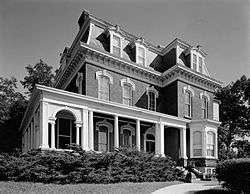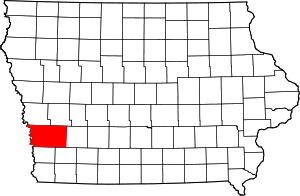Grenville M. Dodge House
The Grenville M. Dodge House is a historic house museum in Council Bluffs, Iowa, United States. This Second Empire mansion, built in 1869, was the home of Grenville M. Dodge (1831-1916), a Union Army general, politician, and a major figure in the development of the railroads across the American West. The house was declared a National Historic Landmark in 1961 for its association with Dodge;[2][3][4] in 2005 it was included as a contributing property in the Willow-Bluff-3rd Street Historic District.[5] It is now owned by the city of Council Bluffs and is open for tours.
Grenville M. Dodge House | |
 General Dodge's house in Council Bluffs, Iowa. | |
| Location | 605 S. 3rd St. Council Bluffs, Iowa |
|---|---|
| Coordinates | 41°15′16.73″N 95°50′49.53″W |
| Area | 1.8 acres (7,300 m2) |
| Built | 1869 |
| Architect | W.W. Boyington |
| Architectural style | Second Empire, Other |
| Part of | Willow-Bluff-3rd Street Historic District (ID05001019) |
| NRHP reference No. | 66000338 |
| Significant dates | |
| Added to NRHP | October 15, 1966[1] |
| Designated NHL | November 5, 1961[2] |
Description and history
The Dodge House is located southeast of downtown Council Bluffs, on the east side of 3rd Street, between 5th and Fairview Avenues. It is a large and rambling three-story brick building, designed by W.W. Boyington of Chicago and built in 1869 at a cost of $35,000. It has a mansard roof with a modillioned eave, pierced by dormers with eared and rounded tops. Most windows are tall and narrow, with segmented-arch tops, some of which have decorative stone hoods. The interior features elaborate interior black walnut woodwork, and original fixtures including bronze hinges with silver butts. The house is decorated with items from the Dodge family. The property also includes an 1871 carriage barn, which houses a caretaker's residence.[3]
Grenville Dodge was involved in railroad construction from an early age, and he distinguished himself with his engineering skills, which were notably applied during the American Civil War in the replacement of destroyed bridges. After the war he became chief engineer of the Union Pacific Railroad, leading the effort that successfully completed the first transcontinental railroad in 1869.[3] In addition to his engineering, Dodge served in managerial and leadership capacities with the railroads, and was politically active, serving in the United States Congress.
Dodge's house remained in the family until 1950, when it was converted into apartments. The city purchased it in 1963 for conversion to a museum, reversing most of the alterations made prior to the period of Dodge's occupancy.[3]
See also
References
- "National Register Information System". National Register of Historic Places. National Park Service. January 23, 2007.
- "Grenville M. Dodge House". National Historic Landmark summary listing. National Park Service. Archived from the original on 2011-06-06. Retrieved 2007-10-03.
- Lissandrello, Stephen (August 5, 1975). "National Register of Historic Places Inventory-Nomination: Grenville M. Dodge House / General Dodge House" (pdf). National Park Service.
- "National Register of Historic Places Inventory-Nomination: Grenville M. Dodge House / General Dodge House—Accompanying photos" (pdf). National Park Service. 1975.
- Leah D. Rogers; Jan Olive Nash; Clare L. Kernek. "Willow-Bluff-3rd Street Historic District". National Park Service. Retrieved 2016-11-13.
External links
| Wikimedia Commons has media related to Grenville M. Dodge House. |
- Historic General Dodge House - official site
